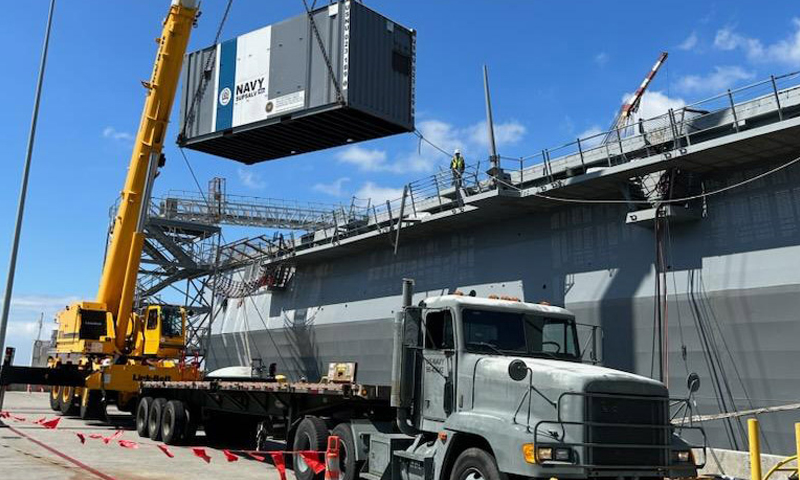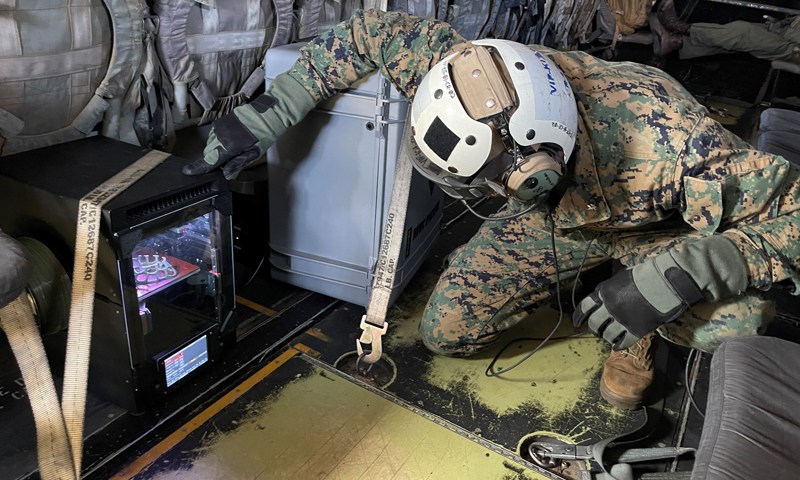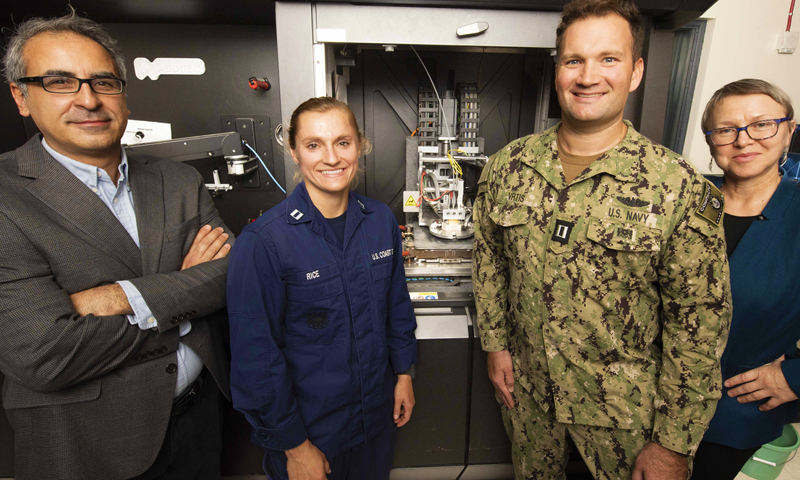Conducting applied research in the operating environment, a team based at the Naval Postgraduate School (NPS) is quickly becoming a key player in the acceleration of adoption of additive manufacturing (AM) – a technology critical to sustainment in austere, contested environments.
The Consortium for Advanced Manufacturing Research and Education (CAMRE) is leveraging NPS’ strong AM foundation and innovation ecosystem, bringing together the right expertise in AM technologies and capabilities with students and seasoned faculty to deliver emerging technologies and capabilities to the warfighter.
From at-sea and in-flight demonstrations aboard U.S. Navy and Marine Corps platforms, to the coordination and facilitation of testing on U.S. Coast Guard vessels in remote areas of the world, CAMRE and its partners are showcasing the potential of additive manufacturing for expeditionary logistics.
For example, in the summer of 2023, the Marine Corps made headlines with the first in-flight 3D printing of a medical cast aboard an MV-22 Osprey tiltrotor aircraft during a training exercise in Southern California. NPS and CAMRE worked with partners at the Marine Innovation Unit (MIU) on the demonstration, which highlighted a key component of the Marine Corps’ Force Design 2030.
“We are just scratching the surface on the capabilities that will come from being able to 3D print in flight,” said U.S. Marine Corps Lt. Col. Michael Radigan, liaison to NPS from the MIU. “Dozens of printers being installed in a modular fashion aboard aircraft brings the ability for mobile production at a scale we have not experienced before.”
Additive manufacturing – or 3D printing, as it’s more commonly known – is the computer-controlled process of creating three-dimensional objects by “printing” material, layer upon layer, to build up an item with the finest of detail. Whether creating a child’s toy or a sophisticated machine part, it is economical and efficient, employing a minimum of resources with a minimum of labor and time.
AM technology is starting to impact industrial production as the world shifts from analog to digital technology. Across the Department of Defense (DOD), 3D printing is recognized as a powerful and versatile tool providing technical advantages across a range of defense applications.
In January 2021, the Department of Defense published its first-ever Additive Manufacturing Strategy to “provide a shared set of guiding principles and a framework for AM technology development and transition to support modernization and Warfighter readiness” across the military.
NPS has a history of early AM technology adoption, starting in 2009 with the installation of a Stratasys 3D printer on campus, and in recent years has explored AM technologies, such as wire-fed AM, liquid metal jetting, and laser powder bed fusion metal AM – a capability which is of interest to the Navy. Additionally, since 2019 the NPS Mechanical and Aerospace Engineering (MAE) Department has offered a dedicated graduate-level AM course which has already educated more than 100 officers who will serve in the fleet.
“This kind of technology is really critical to maintain the superiority of the Navy, and we aim to have our students ready for the challenges ahead,” said NPS Associate Professor Dr. I. Emre Gunduz, the technical lead for CAMRE who has more than 20 years of AM experience. “Their education and training here is crucial, so they can use AM effectively.”
Now in its second year, CAMRE represents a unified effort at NPS dedicated to the enhancement of AM education for defense applications and integration of AM technologies across the Navy, Marine Corps and joint force. CAMRE proliferates new capabilities, delivering hands-on education and developing talent and technologies through applied research with operational forces.

A container with a Xerox ElemX liquid metal 3D printer is transferred aboard the amphibious landing dock USS San Diego (LPD 22) at Naval Base San Diego in September 2023. Installation of the ElemX by NPS’ Consortium for Advanced Manufacturing Research and Education (CAMRE) allows for further testing and evaluation of 3D printing capabilities in an at-sea environment.
CAMRE is truly interdisciplinary in nature, reaching across eight different departments and fields as diverse as mechanical and materials engineering, computer science, cybersecurity, artificial intelligence and defense management.
“CAMRE was congressionally directed as part of an effort to accelerate AM adoption across the tri-service maritime forces – the Navy, Coast Guard and Marine Corps,” explained CAMRE program manager Chris Curran.
According to Curran, success in this mission is accomplished not only by “building on the Z” – referring to the mechanics of 3D printing along all three axes, X, Y and Z – but through education, material sciences advancement, adoption and operational impacts of AM technologies.
“NPS allows us to be very impactful in this and not just build on the Z,” Curran said. “Our goal is to make sure that every Sailor and Marine who is going to use AM is exposed to it. How are we educating them to understand the baseline? How are we integrating augmented and virtual reality technology? How are we using satellite communications to have open discussions with engineers for reach-back support? How do we ensure there’s no counterfeit injected into the system that allows for flaws to be built in by our adversaries? How do we shorten the supply chain? How do we have manufacturing at the point of need? These are the kinds of questions we’re asking [at CAMRE].”
During the first year of its initial funding, CAMRE looked at how NPS could further optimize student exposure to AM technology through new systems at the NPS campus and collaborated with the Naval Systems Engineering Directorate (NAVSEA 05) to accelerate adoption of AM at sea. NAVSEA 05, which is leading the charge for afloat AM, funded the installation of a Philips hybrid 3D printer aboard the amphibious assault ship USS Bataan (LHD 5).
In July 2022, CAMRE partnered with Commander, Naval Surface Forces, U.S. Pacific Fleet (COMNAVSURFPAC) to install a liquid metal printer on the amphibious assault ship USS Essex (LHD 2) during the Rim of the Pacific (RIMPAC) exercise. This was the first time researchers and Sailors were able to test and evaluate a metal printer onboard a ship. Since then, the liquid metal printer has been installed aboard the amphibious transport dock USS San Diego (LPD 22) in preparation for further at-sea testing and evaluation.
What’s more, the technology used by Marines to conduct 3D printing aboard the Osprey in 2023 was also employed in additional tests facilitated by CAMRE, though in two vastly different environments – the Arctic Circle and the South Pacific.
The Advanced Manufacturing Operational System (AMOS), developed at Naval Information Warfare Center (NIWC) Pacific in San Diego, was placed aboard the Coast Guard icebreaker USCGC Healy (WAGB 20) during the vessel’s transit through the Arctic in the summer of 2023.
At the same time, Marines from Combat Logistics Battalion 11, I Marine Expeditionary Force (I MEF), used AMOS to manufacture a shaped explosive charge, allowing them to destroy a World War II-era 500-pound bomb threatening the state legislature building in Pohnpei, Micronesia.
According to Gunduz, the research afforded by these machines continues to be a boon – from fundamental research, ranging from AM of high-performance aerospace aluminum alloys like Al 7075 that are hard to manufacture and application of these materials, to low-density multifunctional metallic structures for autonomous vehicles and energetics.
U.S. Navy Lt. Zachary Vrtis, a Ph.D. candidate at NPS, is doing his research under Gunduz’s supervision. In addition to research in support of his dissertation, titled “Aluminum Alloy Fabrication Methods Using Liquid Metal Printing,” Vrtis is also looking for ways to accelerate adoption of metal AM by the fleet for ship and submarine repair.
“As an Engineering Duty Officer with a background in submarine operations and repair, I am very passionate about improving the throughput of the Navy’s shipyards in order to increase the operational availability of our fleet,” said Vrtis. “The goal of my research is to successfully print aluminum alloy 7075 components with the same material properties as ones produced via traditional methods. From there, the sky is the limit, and I look forward to exploring ways to further improve the strength to weight ratio of components fabricated with Al 7075.”
After NPS, Vrtis will receive orders to a Navy shipyard, and he is looking forward to continuing his collaboration with Gunduz and the CAMRE team.

U.S. Marine Corps Lt. Col. Michael Radigan checks on the 3D printing of a medical cast aboard an MV-22 Osprey from Marine Medium Tiltrotor Squadron (VMM) 164 during a training flight near Twentynine Palms, Calif. in June 2023. The demonstration marked the first successful in-flight demonstration of 3D printing capability in a U.S. military aircraft.
“In addition to my research, I am working with CAMRE and the naval shipyards and repair activities to look for opportunities in upcoming exercises and repairs to prove the value of metal AM,” Vrtis added. “Right now, the Navy is fighting an increasing backlog of maintenance in our shipyards, and I hope to reduce that by finding more and more uses for metal AM.”
Another notable application is modeling and investigating the elemental physics of hypersonics, according to Garth Hobson, CAMRE director and Mechanical and Aerospace Engineering (MAE) professor.
Drawing extensively on the liquid metal printer and a small powder bed metal printer, NPS engineers are able to fabricate a wide variety of components out of different metals, including aluminum and titanium, predict their performance using computational fluid dynamics, and see how they perform under hypersonic conditions.
“We’re using the liquid metal printer to print – you name it: brackets, rake probes,” Hobson said.
For example, U.S. Navy Ensign G. Forrest Dawe, an NPS Aerospace Engineering student, created a device with the liquid metal printer to measure internal conditions to further streamline a newly upgraded wind tunnel.
The recently graduated Dawe attended NPS as a Shoemaker Scholar, putting him on a fast track to earn his master’s degree in just one year after his undergraduate degree at Boston University and before attending Navy flight training in Pensacola, Fla. According to Dawe, his research measured velocity and pressure along the wind tunnel to characterize airflow.
In addition to the research already underway, CAMRE is looking to expand its facilities in the NPS lab annex area, utilizing Building 230 to house additional 3D printers.
Another area of focus as the organization enters its second year is the expeditionary aspect of AM, especially cold spray printing. Cold spray technology blasts a supersonic gas stream heated up to a temperature of 800 to 900 degrees Celsius to “print” dense durable parts of metals, polymers, and composite materials. The kinetic energy of the powders is enough to pancake and bond them together without having to melt the material, hence the “cold” spray.
“We made a strategic decision and purchased an expeditionary cold spray printer,” Curran said. “Strategic subs, Naval Aviation, the Marine Corps and NAVSEA are all interested in cold spray and expeditionary, so buying that one machine means we can still make parts and do research, but we’re not limited to a large machine which stays in one room. It can travel.”
Additionally, the collective interest will yield second-order research funding; as a result, what was programmatically a three-year plus-up now has a seven- or eight-year horizon, with room to grow.
“We’re being very deliberate because CAMRE’s not a program of record,” Curran added. “However, adoption of AM is not a problem that will solve itself in three years. You won’t get full adoption, let alone how you train, educate, track and certify Sailors, Marines and Coast Guardsmen.”
Amela Sadagic, CAMRE co-director and an NPS computer science research associate professor, holds a user-centric approach to AM adoption. She works with her students, whom she credits as having the role of change agents, to develop augmented and virtual reality applications for AM technology and cultivate innovation.
“AM is likely the only technology where domain users – Sailors, Soldiers and Marines – are empowered by the tools that this technology provides to innovate and provide ideas for parts and tools that never existed,” Sadagic said. “So really the only individuals who have knowledge about conditions in their work environments, and what works, what doesn’t work and what breaks, are the domain users.”
“No scientist and no company is privy to that type of information,” she added.
Sadagic cites the time a Sailor had to bring four different tools up a ladder to maintain a system. He knew that chances were at least one of the tools dropping, so the Sailor came up with the idea of forging one single tool that integrated all four functions.
“To me, that was ingenious,” she said. “Sometimes when you approach individuals who are educated, they have a way of seeing advances and benefits in a way that things get enabled faster.”
That, Sadagic continued, is CAMRE’s goal: to touch as many Sailors and Marines as possible so that down the road, the way is paved for the adoption of AM technology.
“We are growing an army of people who will be informed and able to support innovation in AM,” Sadagic said.


